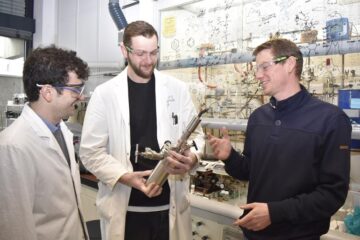Addressing pain and disease on the fly

Studies of a protein that fruit flies use to sense heat and chemicals may someday provide solutions to human pain and the control of disease-spreading mosquitoes.
In the current issue of the journal Nature, biologist Paul Garrity of the National Center for Behavioral Genomics at Brandeis University and his team, spearheaded by KyeongJin Kang and Vince Panzano in the Garrity lab, report how fruit flies distinguish the warmth of a summer day from the pungency of wasabi by using TRPA1, a protein whose human relative is critical for contolling pain and inflammation.
In earlier research Garrity’s team showed that flies, like humans, sense chemical irritants with TRPA1, indicating an ancient origin for harmful chemical sensing. In 2008, the team demonstrated that this protein serves a second function in flies: sensing warmth.
Gentle warmth and nasty chemicals trigger distinct responses. How can both responses rely on the same sensor? The team has now discovered that there is an easy answer. Insects actually make two forms of TRPA1, one specialized for each task.
What is the significance of this new research?
Such TRPA1 specialization has implications for devising bug sprays and traps to combat the transmission of diseases like malaria, dengue and West Nile virus. “This work on TRPA1 can explain how blood-sucking insects like mosquitoes discriminate noxious chemicals, which repel them, from the warmth of a human, which attracts them,” says Garrity. “By activating one kind of TRPA1 you might be able to deter mosquitoes from biting you, while activating the other kind of TRPA1 might lure mosquitoes to a trap.”
These findings also have implications for understanding the way that human damage-sensing neurons work, explains Garrity. Since human TRPA1 is a drug target aimed at treating diseases such as asthma, migraines, and chronic pain, Garrity says it’s important to understand how TRPA1 proteins operate.
“Fruit flies are easy to work with in the lab and this lets us test hypotheses about how TRPA1 operates quickly and relatively cheaply.” Says Garrity. “Fortunately, the function of TRPA1 seems evolutionarily ancient and conserved from flies to mosquitoes to humans, so one can gain insights of general biomedical relevance using flies.”
“Untreatable chronic pain and insect-borne diseases are two major human health problems,” says Garrity. “When you think about basic research translating into treatments to help people, work in these areas has tremendous potential for easing human misery.”
The study was funded by the National Science Foundation, National Institute of Mental Health and the National Institute of Neurological Disorders and Stroke.
Media Contact
More Information:
http://www.brandeis.eduAll latest news from the category: Life Sciences and Chemistry
Articles and reports from the Life Sciences and chemistry area deal with applied and basic research into modern biology, chemistry and human medicine.
Valuable information can be found on a range of life sciences fields including bacteriology, biochemistry, bionics, bioinformatics, biophysics, biotechnology, genetics, geobotany, human biology, marine biology, microbiology, molecular biology, cellular biology, zoology, bioinorganic chemistry, microchemistry and environmental chemistry.
Newest articles

Lower dose of mpox vaccine is safe
… and generates six-week antibody response equivalent to standard regimen. Study highlights need for defined markers of mpox immunity to inform public health use. A dose-sparing intradermal mpox vaccination regimen…

Efficient, sustainable and cost-effective hybrid energy storage system for modern power grids
EU project HyFlow: Over three years of research, the consortium of the EU project HyFlow has successfully developed a highly efficient, sustainable, and cost-effective hybrid energy storage system (HESS) that…

Safer alternative for an explosive reaction
The chemical industry has been using a reaction with explosive chemicals for over 100 years – now Mülheim scientists have discovered a safer alternative. The Ritter Group of the Max…





















